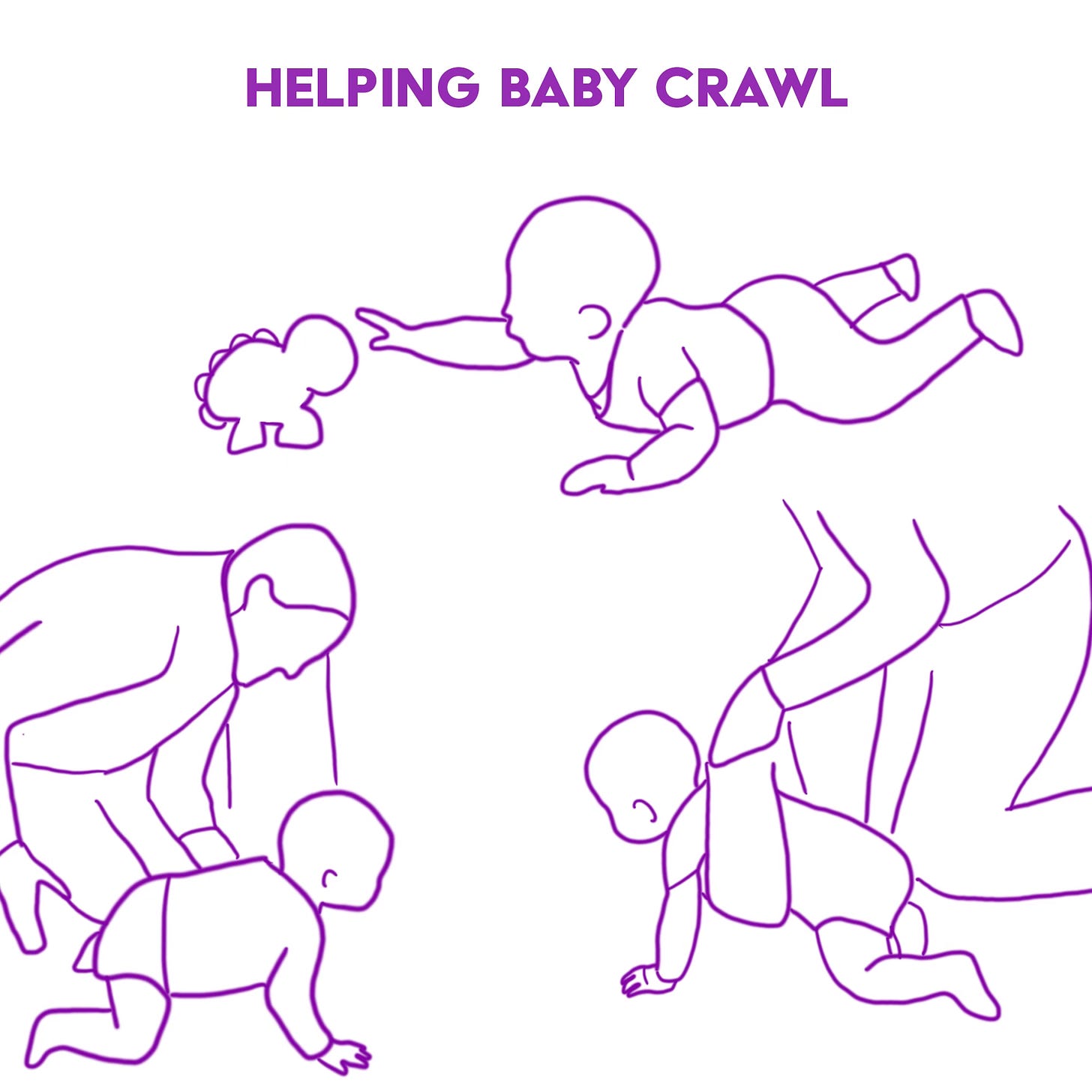It takes a lot of skill for babies to learn how and start to crawl.
They need to develop upper body and lower body strength, manage to get up on all fours, and then coordinate their arms and legs simultaneously to propel themselves forward. (And in some cases, babies go backward).
Most babies will learn to crawl between 6-10 months old. (Some sooner, some later, some never). Some babies struggle to crawl and skip it altogether (start walking or standing before even crawling). But we want to do what we can to encourage them to crawl to help with mobility and overall development (especially posture and coordination).
This will look different for every baby - some start with army crawling, crab crawling or rolling, whatever they can do to move around, and our goal as parents is to get them to a quadruped crawl (on all fours).
Some questions to ask when approaching this milestone (crawling):
Is your baby doing tummy time?
Is your baby trying to walk or stand?
Does your baby seem interested in exploring their surrounding environment?
Are there other ways they seem interested in moving around (read: scooting, rolling)?
Crawling (Mini) Milestones / Progression of crawling:
Tolerating tummy time
Tolerating tummy time with elbows bent underneath them
Baby pushes up on extended elbows while in tummy time
Baby starts weight shifting on one side to reach for things
Starts using arms and legs (uncoordinated) to move to toys
Commando crawling on the tummy (this can be one-sided)
Starts rocking on hands and knees - building upper body strength
Starts crawling while on hands and knees (quadruped crawl)
Baby is finally crawling symmetrically as their main form of movement!
Babies must do tummy time because it helps strengthen their necks, core, and upper body muscles1. This will lead your baby to sit up, crawl, and eventually walk. So what if your baby doesn’t like tummy time?
Here are a few simple tips to get them interested in tummy time:
Place your baby on your chest (this is especially recommended if they have reflux and “regular” tummy time is uncomfortable for them). You can talk to them and create an environment for them to look up at you (this will help with neck strength).
Lay next to your baby and talk to them or sing to them. Getting on their level makes them more comfortable and gives them a sense of protection. This can also encourage them to turn their head (so switching sides can be beneficial here).
Put toys in front of them that they tend to enjoy. (High contrast works best for newborns, they can’t see color yet! They start to see color around 4 months fully).
Some babies like to look in the mirror so placing a mirror in front of them can also be beneficial.
Put a pillow (or a rolled towel/blanket/etc.) under your baby’s arms to allow them to look around more freely by making it easier for them to push up on their arms and hold their head up.
This goes hand in hand with getting them interested in their environment. Even if tummy time is successful and you aren’t seeing any improvement in crawling, they may be more motivated by spreading toys out—or moving yourself around the room and waiting for them to follow or reach for you.
Every baby has a different progression, but most will start on the tummy, figure out how to roll, start some form of movement (army crawl, scoot, crab crawl, etc.), and eventually begin crawling. Whether they take days or weeks for each phase doesn’t matter much, as long as they are progressing.
Doing Our Part
Limit their time spent in seats, swings, strollers, car seats, baby entertainment centers, bouncers, etc. This equipment limits their ability to move around and explore. This does not mean avoiding them altogether, just give your baby ample time to get acquainted with independent exploration.
Give them an Incentive! Just like with tummy time, you can place a toy in front of your baby (almost within reach) to encourage them to nudge forward or reach for the toy (this helps to strengthen arm muscles). As they get older and start to go for the toy, pull it back gradually. They will follow!
Encourage high-kneeling play (baby standing on their knees) to help straighten core muscles. Encourage them with toys like a Deluxe Activity Cube.
Hold your baby up in a crawling position and support their movement (support the abdomen so they can focus on their arms and legs doing the work).
Do the last step but with a towel or blanket (a swaddle can work too) around their hips.
When a baby is on all fours, give them an encouraging “boost” by gently pushing their bum forward. This will urge them to lunge forward or rock.
Many babies learn how to rock on all fours and stay in that stage for a week or two. This is great progress.
In short, you can narrow these skills down to:
Pushing up (strengthening arm muscles).
Playing on knees (strengthening core).
Rolling back & forth
Maintaining hands & knees position (tabletop)
Reaching for objects
Anyway, just do your best and let them go at their own pace! Your baby will be crawling in no time. :)
#WAGMI
Your friend,
- BowTiedHeifer
Disclaimer
I am not a licensed personal trainer or pre/postnatal specialist—these are simply my personal experiences and things I have witnessed to work for many others. This is not legal, medical or financial advice. Please speak to a professional before starting any new programs, applying any new diet plans, or supplement protocols.




